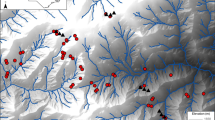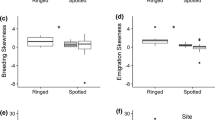Abstract
Plasticity in life history strategies can be advantageous for species that occupy spatially or temporally variable environments. We examined how phenotypic plasticity influences responses of the mole salamander, Ambystoma talpoideum, to disturbance events at the St. Marks National Wildlife Refuge (SMNWR), FL, USA from 2009 to 2014. We observed periods of extensive drought early in the study, in contrast to high rainfall and expansive flooding events in later years. Flooding facilitated colonization of predatory fishes to isolated wetlands across the refuge. We employed multistate occupancy models to determine how this natural experiment influenced the occurrence of aquatic larvae and paedomorphic adults and what implications this may have for the population. We found that, in terms of occurrence, responses to environmental variation differed between larvae and paedomorphs, but plasticity (i.e. the ability to metamorphose rather than remain in aquatic environment) was not sufficient to buffer populations from declining as a result of environmental perturbations. Drought and fish presence negatively influenced occurrence dynamics of larval and paedomorphic mole salamanders and, consequently, contributed to observed short-term declines of this species. Overall occurrence of larval salamanders decreased from 0.611 in 2009 to 0.075 in 2014 and paedomorph occurrence decreased from 0.311 in 2009 to 0.121 in 2014. Although variation in selection pressures has likely maintained this polyphenism previously, our results suggest that continued changes in environmental variability and the persistence of fish in isolated wetlands could lead to a loss of paedomorphosis in the SMNWR population and, ultimately, impact regional persistence in the future.
Similar content being viewed by others
References
Akaike H (1973) Information theory and an extension of the maximum likelihood principles. In: Petrov BN, Csaki F (eds) 2nd international symposium on information theory. Akademiai Kiado, Budapest
Anderson TL, Ousterhout BH, Peterman WE, Drake DL, Semlitsch RD (2015) Life history differences influence the impacts of drought on two pond-breeding salamanders. Ecol Appl 25:1896–1910
Babbitt KJ, Baber MJ, Tarr TL (2003) Patterns of larval mole salamander distribution along a wetland hydroperiod gradient. Can J Zool 1552:1539–1552
Bailey LL, Reid JA, Forsman ED, Nichols JD (2009) Modeling co-occurrence of northern spotted and barred owls: accounting for detection probability differences. Biol Conserv 142:2983–2989
Caldwell JP, Thorp JH, Jervey TO (1980) Predator–prey relationships among larval dragonflies, salamanders, and frogs. Oecologia 46:285–289
Cancelliere A, Di Mauro G, Bonaccorso B, Rossi G (2007) Drought forecasting using the standardized precipitation index. Water Resour Manag 21:801–819
Church DR, Bailey LL, Wilbur HM, Kendall WL, Hines JE (2007) Iteroparity in the variable environment of the salamander Ambystoma tigrinum. Ecology 88:891–903
Davis CL, Miller DAW, Walls SC, Barichivich WJ, Riley JW, Brown ME (2016) Species interactions and the effects of climate variability on a wetland amphibian metacommunity. Ecol Appl Accept Author Manuscr. doi:10.1002/eap.1442
Denoël M, Ficetola GF, Cirović R, Radovic D, Džukić G, Kalezić ML, Vukov TD (2009) A multi-scale approach to facultative paedomorphosis of European newts (Salamandridae) in the Montenegrin karst: distribution pattern, environmental variables, and conservation. Biol Conserv 142:509–517
Doyle JM, Nolan JR, Whiteman HH (2010) Effects of relative size on growth rate and time to metamorphosis in mole salamanders (Ambystoma talpoideum). J Herpetol 44:601–609
Doyle JM, Whiteman HH (2008) Paedomorphosis in Ambystoma talpoideum: effects of initial body size variation and density. Oecologia 156:87–94
Falke JA, Bailey LL, Fausch KD, Bestgen KR (2012) Colonization and extinction in dynamic habitats: an occupancy approach for a Great Plains stream fish assemblage. Ecology 93:858–867
Guttman NB (1998) Comparing the palmer drought index and the standardized precipitation index. J Am Water Resour Assoc 34:113–121
Jackson ME, Semlitsch RD (1993) Paedomorphosis in the salamander Ambystoma talpoideum: effects of a fish predator. Ecology 74:342–350
Jenkins K, Warren R (2015) Quantifying the impact of climate change on drought regimes using the standardised precipitation index. Theor Appl Climatol 120:41–54
MacKenzie DI, Bailey LL, Hines JE, Nichols JD (2011) An integrated model of habitat and species occurrence dynamics. Methods Ecol Evol 2:612–622
MacKenzie DI, Bailey LL, Nichols JD (2004) Investigating species co-occurrence patterns when species are detected imperfectly. J Anim Ecol 73:546–555
MacKenzie DI, Nichols JD, Hines JE, Knutson MG, Franklin AB (2003) Estimating site occupancy, colonization and local extinction when a species is detected imperfectly. Ecology 84:2200–2207
MacKenzie DI, Nichols JD, Seamans ME, Gutiérrez RJ, James D (2009) Modeling species occurrence dynamics with multiple states and imperfect detection. Ecology 90:823–835
Miller DAW, Brehme CS, Hines JE, Nichols JD, Fisher RN (2012) Joint estimation of habitat dynamics and species interactions: disturbance reduces co-occurrence of non-native predators with an endangered toad. J Anim Ecol 81:1288–1297
Moran N (1992) The evolutionary maintenance of alternative phenotypes. Am Nat 139:971–989
National Climatic Data Center (2014) Climate Data Online. Climatic Indices. http://www7.ncdc.noaa.gov/CDO/cdodivisionalselect.cmd?nationSelect=110&startMonthSelect=01&startYearSelect=2008&endMonthSelect=01&endYearSelect=2015&outputRadio=Text&textOutputSelect=space&method=doTextOutput&reqtype=division. Accessed March 2015
Patterson KK (1978) Life history aspects of paedogenic populations of the mole salamander, Ambystoma talpoideum. Copeia 1978:649–655
Petranka JW (2010) Salamanders of the United States and Canada. Smithsonian Books
R Core Team (2014) R Language and environment for statistical computing. R Foundation for Statistical Computing. Vienna, Austria. http://www.R-project.org/
Rittenhouse TAG, Semlitsch RD, Thompson FR (2009) Survival costs associated with wood frog breeding migrations: effects of timber harvest and drought. Ecology 90:1620–1630
Ryan TJ, Plague GR (2004) Hatching asynchrony, survival, and the fitness of alternative adult morphs in Ambystoma talpoideum. Oecologia 140:46–51
Ryan TJ, Semlitsch RD (2003) Growth and the expression of alternative life cycles in the salamander Ambystoma talpoideum (Caudata: ambystomatidae). Biol J Linn Soc 80:639–646
Scott DE (1993) Timing of reproduction of paedomorphic and metamorphic Ambystoma talpoideum. Am Midl Nat 129:397–402
Semlitsch RD (1985a) Analysis of climatic factors influencing migrations of the salamander Ambystoma talpoideum. Copeia 1985:477–489
Semlitsch RD (1985b) Reproductive strategy of a facultatively paedomorphic salamander Ambystoma talpoideum. Oecologia 65:305–313
Semlitsch RD (1987) Interactions between fish and salamander larvae: costs of predator avoidance or competition? Oecologia 72:481–486
Semlitsch RD (2008) Differentiating migration and dispersal processes for pond-breeding amphibians. J Wildl Manag 72:260–267
Semlitsch RD, Gibbons JW (1985) Phenotypic variation in metamorphosis and paedomorphosis in the salamander Ambystoma talpoideum. Ecology 66:1123–1130
Semlitsch RD, Harris RN, Wilbur HM (1990) Paedomorphosis in Ambystoma talpoideum: maintenance of population variation and alternative life-history pathways. Evolution 44:1604–1613
Semlitsch RD, Scott DE, Pechmann JHK (1988) Time and size at metamorphosis related to adult fitness in Ambystoma talpoideum. Ecology 69:184–192
Semlitsch RD, Wilbur HM (1988) Effects of pond drying time on metamorphosis and survival in the salamander Ambystoma talpoideum. Copeia 1988:978–983
Walls SC, Barichivich WJ, Brown ME (2013a) Drought, deluge and declines: the impact of precipitation extremes on amphibians in a changing climate. Biology 2:399–418
Walls SC, Barichvich WJ, Brown ME, Scott DE, Hossack BR (2013b) Influence of drought on salamander occupancy of isolated wetlands on the Southeastern Coastal Plain of the United States. Wetlands 33:345–354
Whiteman HH (1994) Evolution of facultative paedomorphosis in salamanders. Q Rev Biol 69:205–221
Acknowledgements
We thank Katherine M. O’Donnell, Katriona Shea, and Tyler Wagner for insightful feedback on an earlier version of this manuscript. Any use of trade, product, or firm names is for descriptive purposes only and does not imply endorsement by the US Government. This manuscript is contribution#553 of the Amphibian Research and Monitoring Initiative (ARMI) of the US Geological Survey.
Author contribution statement
CLD and DAWM analyzed occurrence data and prepared the manuscript; SCW, WJB, and JWR designed the study and along with MEB led data collection in the field. All authors contributed input into the design and interpretation of the analysis and contributed to writing the final manuscript.
Author information
Authors and Affiliations
Corresponding author
Ethics declarations
Conflict of interest
The authors declare that they have no conflict of interest.
Ethical approval
All applicable institutional and/or national guidelines for the care and use of animals were followed.
Additional information
Communicated by Pieter Johnson.
While the drivers of paedomorphosis have previously been examined, few studies have applied advanced quantitative methods to understand how those dynamics structure responses to environmental change.
Electronic supplementary material
Below is the link to the electronic supplementary material.
Rights and permissions
About this article
Cite this article
Davis, C.L., Miller, D.A., Walls, S.C. et al. Life history plasticity does not confer resilience to environmental change in the mole salamander (Ambystoma talpoideum) . Oecologia 183, 739–749 (2017). https://doi.org/10.1007/s00442-017-3810-y
Received:
Accepted:
Published:
Issue Date:
DOI: https://doi.org/10.1007/s00442-017-3810-y








